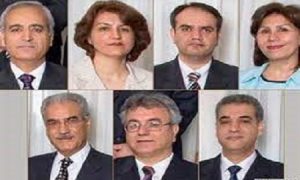During all of its periods of existence and in each country where it has been present the Baha’ism organization has shown an anti-national identity. This behavior of Baha’ism has been too many in Iran. This cult which had been come into existence supported by foreign countries during Qajar period of time, had possessed a strong political, cultural, military and economic position during Pahlavi period of time and supported by the government.
During Pahlavi period of time, the government had let the Baha’is to do each kind of activity and the Baha’is had penetrated political and occupational activities and they were always trying to change cultural and theological contexts of the Iranians according to their desires.
Also, the Baha’is had confiscated high-ranking posts and the security ones in the country to do all kinds of spying. For example, according to SAVAK documents concerning the Baha’is spying for America and England, it has been written that: “Haziratul Qods of Tehran city has announced in a letter to all assemblies of Iran that all the Baha’i who are serving in armed forces of kingdom are under control. Send all the names of military people from soldier to general in a note to Haziratul Qods of Tehran city in order to be sent to the universal house of justice and London and America[1].”
Generally speaking, The Iranian country was important among the world countries as the place for the emergence of Baha’ism or according to them “the cradle of God’s faith”.
The suitable position of the Baha’is during the Pahlavi regime had caused them to be opposed with each kind of political change and transformation inside Iran.
So, each kind of democratic and religious movements which caused the position of Baha’ism to be unstable was opposed by this cult.
Islamic Revolution and the Baha’i assemblies
After the Islamic Revolution when the documents of Baha’ism betrayals were revealed in the country, the organization felt be endangered. So; in 1362 S.H., the Islamic Republic of Iran announced that the Baha’ism organization and the spiritual assemblies are illegal. Baha’ism whose main center was supervised by the Zionistic regime was sending puce data of the real lives of Iranian people to America and Israel. It can be said that after the victory of the Islamic Revolution and announcing this organization to be illegal, the aliens and their hired men-like Baha’ism dimentions such as political, military, economic and cultural ones of the Islamic Iran.
Thus, the Baha’ism organization stated: “According to the Excellency guardian of the faith on Nov. 1928 A.D., what is said by the guardians of affairs and local and central rulers of that region concerning forming assemblies and proselytizing and preaching must be totally obeyed …[۲]”
After apparently obeying by the law, Baha’ism tried to put the system of the Iranian government under pressures politically and economically using the policy of pretending to be oppressed and asking the international forums for help.
Alongside with the policy of pretending to be oppressed and pressure, the Baha’ism organization changed the name of the Iranian national assembly to “the disciples of Iran” regardless of the law and even its claiming for obeying the government on Aban, 1385 S.H., it appointed nine other people as the new managers of Baha’ism: “The universal house of justice announces the appointment of dear friends whose names are mentioned in alphabetical order as the members of the board of Iranian disciples[3].”
They were Behrouz Tawakoli, Vahid Tiz Fahm, Mahvash Sabet, Jamaluddin Khanjani, Saeed Rezaee, Fariba Kamal Abadi and Afif Naeemi. These nine people were acting as communicative canals among local, national and international foundations of Baha’ism and taking on the responsibility of activities such as educational affairs, preaching Baha’i teachings, marriage and in general managing the affairs of Baha’i community. They had become the center for anti-revolution management and organizing and the supporter of those who wanted to overthrow the Iranian government.
Anyway, appointing the organizational people in charge and bestowing so-called important responsibilities to them were violating the law and a kind of organizational organizing. Meanwhile, offering various plans and pursuing in Iran, Baha’ism didn’t ignore its sectarian activities even for a moment:
“The brave resistance of the disciples of the cradle of God’s faith has created great spiritual powers in the world… what must be considered is that the best way for expressing this enthusiasm is focusing on executing the 5-year plan powerfully[4].”
These plans were aimed to recruit people to Baha’ism particularly the Baha’i thought to supervise the educational activities and people-founded organizations.
Generally speaking, Baha’ism is following the following purposes via pretending to be oppressed: destroying Iran and revolution popularity, hiding its theological weaknesses, justifying their crimes and betrayals; recruiting, attracting the people of the world’s attention, receiving various opportunities from the international assemblies and putting pressures on the Islamic Republic of Iran.
[۱] Mansouri, Jawad, the history of 15th of Khordad narrated by documents, Tehran: The center for the documents of the Islamic Revolution, Vol. 1, 1378 S.H., document No. 92.2.
[۲] The message of the national assembly of Iran, Shahrivar, 12, 1362 S.H.
[۳] The letter of Darul Ensha’, the main center of the cult
[۴] The message of the main center of the cult to the national spiritual assemblies, March, 6, 2009 A.D.






